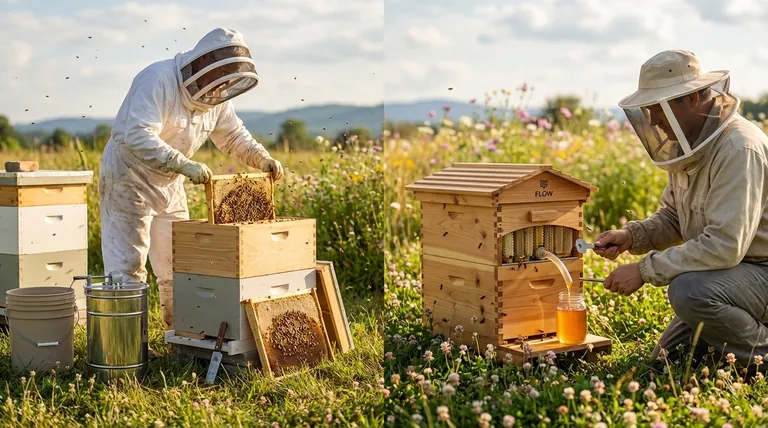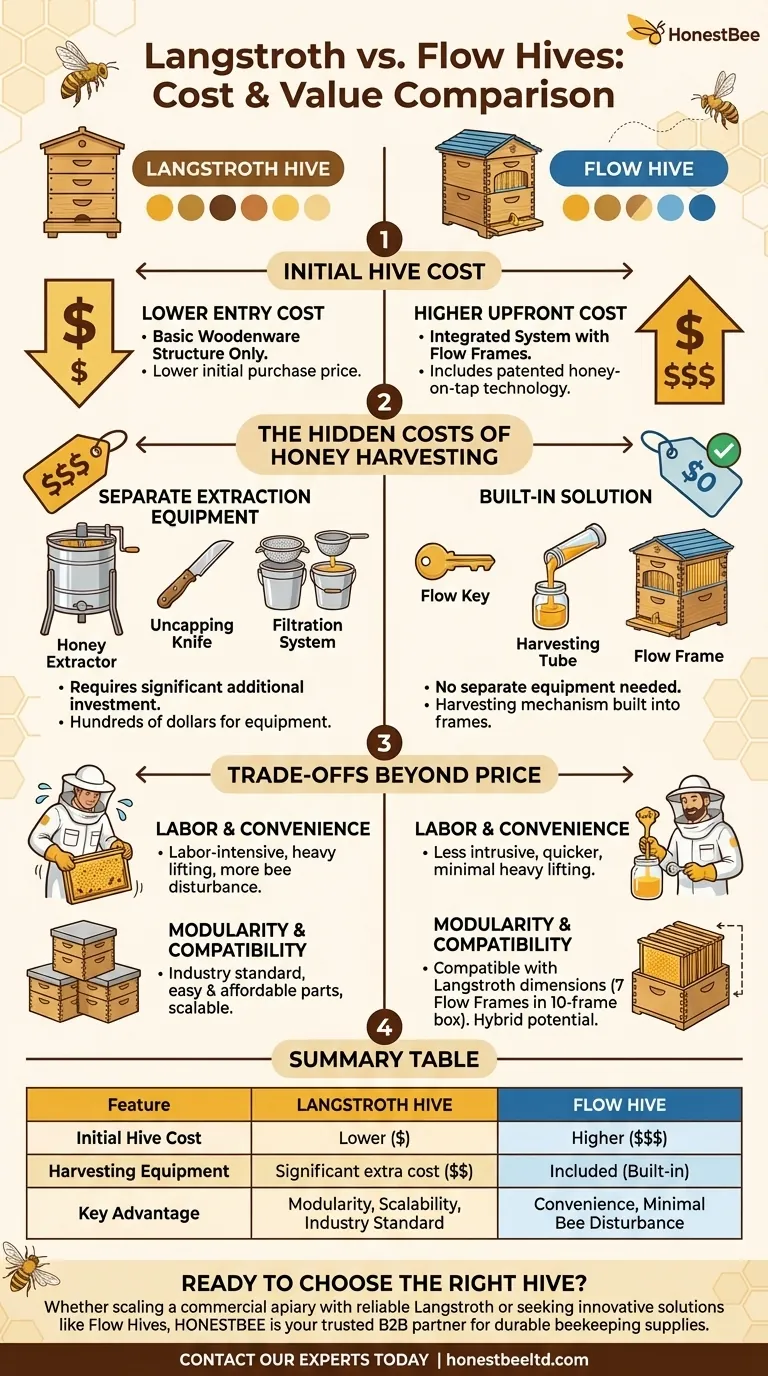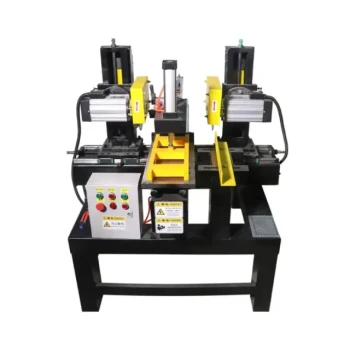At first glance, a Flow Hive has a significantly higher upfront cost than a standard Langstroth hive. The price difference is substantial, often several hundred dollars more for a complete Flow Hive setup compared to a basic Langstroth kit. However, this initial price tag does not represent the total cost of ownership, as the Langstroth system requires separate, often expensive, equipment for honey harvesting.
The core financial difference is not just in the hive itself, but in the harvesting process. A Flow Hive bundles the cost of a convenient, built-in extraction system into its initial price, while a Langstroth hive has a lower entry cost but requires a separate investment in honey extraction equipment.

Deconstructing the Initial Investment
To understand the full picture, we must break down the costs associated with each hive type from purchase to the first honey harvest.
The Upfront Cost of a Flow Hive
A Flow Hive is best understood as an integrated system. Its higher price reflects the inclusion of its patented honey-on-tap technology.
The initial purchase typically includes the hive bodies (brood box and super) as well as the specialized Flow Frames. This all-in-one approach is designed for simplicity and convenience.
The Upfront Cost of a Langstroth Hive
A Langstroth hive has a much lower initial purchase price for the basic woodenware. Its cost can vary based on the type of wood and the manufacturer.
However, this base price only covers the structure of the hive. It does not include any of the tools required to get honey out of the frames.
The Hidden Costs of Honey Harvesting
The primary cost divergence appears when it's time to harvest your honey. This is where the initial savings of a Langstroth can be offset by subsequent purchases.
Langstroth: The Equipment Factor
To harvest honey from a Langstroth hive, you must invest in separate extraction equipment. This often includes:
- A honey extractor (which can cost hundreds of dollars)
- An uncapping knife or roller
- A filtration system (strainers and buckets)
- Storage containers
This equipment adds a significant secondary cost to the Langstroth system, closing the price gap with the Flow Hive.
Flow Hive: The Built-in Solution
The Flow Hive eliminates the need for this separate equipment. The harvesting mechanism is built directly into its specialized frames.
By simply turning a key, the honeycomb cells are split, allowing honey to drain directly out of the hive via a tube. This convenience and avoidance of extra equipment costs are the central value proposition of the Flow Hive.
Understanding the Trade-offs Beyond Price
Your decision shouldn't be based solely on a spreadsheet. The two systems offer fundamentally different beekeeping experiences.
Labor and Convenience
Harvesting from a Langstroth hive is a labor-intensive process that involves heavy lifting, removing frames, and disturbing the bees significantly.
The Flow Hive method is far less intrusive to the colony and physically easier for the beekeeper. The process is quicker and requires minimal heavy lifting.
Modularity and Compatibility
The Langstroth design is the industry standard. This makes finding replacement parts, accessories, and additional boxes from various manufacturers easy and affordable.
The Flow Hive was cleverly designed to match Langstroth dimensions. This means you can use Flow Frames inside a standard Langstroth super, offering a potential hybrid approach. Note that Flow Frames are wider, so a 10-frame Langstroth box will only accommodate 7 Flow Frames.
Essential Bee Care
Regardless of your choice, the core responsibilities of beekeeping remain the same. Both hive types require regular inspections for pests and diseases to ensure the health and productivity of your colony.
Making the Right Choice for Your Goal
The "better" hive depends entirely on your personal goals, budget, and how you wish to interact with your bees.
- If your primary focus is convenience and a simplified hobby experience: The Flow Hive's all-in-one system justifies its higher initial cost by making honey harvesting incredibly simple.
- If your primary focus is the lowest possible entry cost and a traditional experience: The Langstroth hive is the clear choice, allowing you to learn classic beekeeping methods and spread out your equipment costs over time.
- If your primary focus is scalability and customization: The Langstroth hive's modularity and status as the industry standard make it the superior platform for expansion and modification.
Ultimately, the best investment is the one that aligns with your beekeeping philosophy and keeps you engaged with the fascinating world of your bees.
Summary Table:
| Hive Type | Initial Hive Cost | Harvesting Equipment Cost | Key Advantage |
|---|---|---|---|
| Flow Hive | Higher ($$$) | Included (Built-in) | Convenience, minimal bee disturbance |
| Langstroth Hive | Lower ($) | Significant extra cost ($$) | Modularity, industry standard, scalability |
Ready to choose the right hive for your operation?
Whether you're a commercial apiary scaling up with reliable Langstroth equipment or a distributor looking for innovative solutions like Flow Hives, HONESTBEE is your trusted wholesale partner. We supply the durable beekeeping supplies and equipment you need to succeed.
Contact our experts today to discuss your specific needs and get a competitive quote. Let's build a more productive and profitable apiary together.
Visual Guide

Related Products
- Langstroth Honey Bee Box Hive Boxes for Different Depths
- Professional Galvanized Hive Strap with Secure Locking Buckle for Beekeeping
- Multi-Functional Sliding Hive Entrance for Beekeeping
- Jenter Queen Rearing Kit Complete Set for Bee Breeding
- HONESTBEE Durable Frame Wiring Board with Integrated Tensioner
People Also Ask
- What factors should beekeepers consider when choosing between wooden and polystyrene hives? Maximize Bee Health and Honey Production
- What are the sizes of supers available in a standard hive? A Guide to Deep, Medium, and Shallow Boxes
- What are the sizes available for Langstroth boxes? A Guide to 8-Frame vs. 10-Frame & Depths
- What is the purpose of the boxes in a Langstroth hive? A Guide to Modular Beekeeping Success
- How deep is a medium bee box? Unlock the Key to a Versatile and Manageable Hive



















